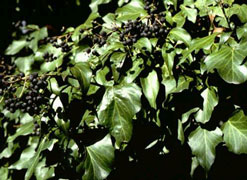


Home
Flowers &
Indoor Plants
Fruits & Nuts
Ornamentals
Vegetables
Special Topics
Resources
Glossary

 |
What about it? This native of the area from the Canary Islands to Asia is a vine that clings to walls with the assistance of "holdfasts." Its leaves and berries contain poisonous glucosides; some people are irritated just from handling the leaves. The leaves are evergreen, three- to five-lobed, dark green above and lighter beneath. English Ivy can be reproduced by both seeds and cuttings. What is it used for? This plant can be seen covering the sides of buildings made of brick or stone; in fact, it is one of the ivies of the "Ivy League." Its foliage is very attractive. It is also grown as a groundcover or houseplant. Where does it grow? How do we grow it? The English Ivy will grow best in Central New York and milder areas; it needs shade and protection in colder areas. A moist, well-drained, fertile soil is ideal. What are its primary problems? English Ivy may be bothered by red spider mites, the injury of which shows up as a bronzing of the foliage. Winter foliar bum and twig kill may occur in exposed locations.
© Copyright, Department of Horticulture, Cornell University. |

